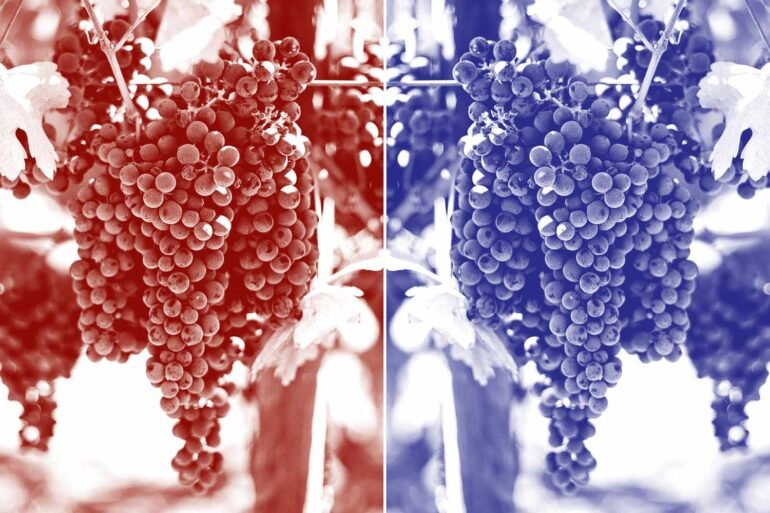:max_bytes(150000):strip_icc():format(jpeg)/Syrah-vs-Shiraz-FT-BLOG0925-e80f30b388ba41ea92578c419d012d62.jpg)
The differences between Syrah and Shiraz are a bit like tomato or to-MAH-to. No matter how you slice it, they’re the same grape. However, despite representing the same variety, each name tends to reflect a distinct style or place of origin. This means that the term you see on a label can reflect greatly on what you’ll experience within the bottle.
“The names Syrah and Shiraz are indicative of origin and its associated style, but the defining characteristics of the grape remain,” says Abe Zarate, wine director at Crane Club. “Think of it as someone named John being called Juan if they grew up in Mexico. Generally, we call the wine Syrah when it comes from France, and Shiraz if it comes from Australia.”
Zarate says that while the Northern Rhône is Syrah’s viticultural home, the variety is cultivated across the world.
“Some of those regions are considered classic examples as well — South Africa: Swartland, Stellenbosch; and domestically, California: Sonoma Coast, Paso Robles; along with one of my favorites, Washington State: Walla Walla, Yakima Valley,” he says.
For the variety, factors like climate, soil, and topography play heavily into a wine’s flavor profile and the characteristics of each moniker’s style. More commonly, wines from France and other cooler regions will employ the name Syrah and offer a leaner, more high-acid and moderate-tannin sip, with pronounced peppery spice. Selections from Australia and other warmer climates will often yield jammier, fuller-bodied and more tannic expressions of Shiraz.
Considering the source of the grapes and their corresponding terroir will help guide consumers as to what to generally expect from the sip.
In terms of specific flavors, Zarate describes the intrinsic qualities of the grape as having notes of dark fruit, dried herbs, violets, black pepper, and a savoriness that can turn into meatiness with age.
“The dark fruit notes of Syrah from the cool climate of the Northern Rhône will be powerful but restrained, whereas Shiraz from a much warmer Barossa Valley in Australia will show its dark fruit as much riper, with elevated alcohol, a fuller body, and bolder structure all around,” he says.
Additional common characteristics of Syrah include blackcurrant, blackberry, red plum, raspberry, smoked meat, pepper, and black olives, along with earthy and floral nuances. With Shiraz, fruit flavors such as blackberry, black plum, and blueberry can veer more into the jammy spectrum of ripeness, with additional notes of smokiness and sweet baking spices.
Courtesy of Mullineux Family Wines
Zarate says that there are always exceptions to the rules. Cool-climate expressions can be found in Australia, and vice versa.
“Many producers in these cooler-climate Australian regions — Victoria or Yarra Valley — will choose to label their wines as Syrah over Shiraz to visually communicate that the wine will taste similar to its French counterparts,” he says.
Similar labeling intentionality can be found from winemakers in the U.S. and South Africa, as producers seek to alert consumers as to what general style of fruitiness, alcohol, spice, and structure to expect from their bottlings.
There are many threads that tie the two together, but the shared food-friendliness of Syrah and Shiraz is unmatched. Grilled lamb chops, roasted duck breast, venison, and cassoulet are all classic pairings for cooler-climate Syrah, while heavier dishes like rib eye, brisket, and short ribs come to life when served with jammier expressions of Shiraz.
Zarate cites grilled meats, barbecue, and hard cheeses as his favorite pairings for the grapes. He says that any dishes prepared with thyme, rosemary, or ample amounts of pepper are equally delightful with the wines.
So, when is Syrah or Shiraz a better choice than the other? To Zarate, it’s simply a matter of mood and personal preference.
“If you’re feeling cozy and warm, Shiraz from Barossa or Walla Walla might enhance that,” he says. “If you’re feeling bold and edgy, you can’t go wrong with a youthful Syrah from Côte-Rôtie or Sonoma Coast.”
6 Bottles of Syrah/Shiraz to Try
2018 d’Arenberg The Dead Arm McLaren Vale Shiraz ($50)
An Australian standard, this 100% Shiraz is aged in a combination of new and used French oak barriques. It’s ripe and packed with flavor, boasting notes of black fruits, licorice, tobacco, iodine, and sweet spice.
2023 Jean-Louis Chave Selection Saint-Joseph Offerus ($35)
This 100% Syrah from the Northern Rhône is vinified with 50% whole clusters and aged in a combination of barriques and foudres for 18 months. It’s smoky and peppery, with notes of red fruits, violets, and scorched earth.
2022 Mullineux Family Wines Swartland Syrah ($45)
This South African Syrah is silky and elegant, with flavors of blackberry, violet, and olive tapenade. It’s made exclusively from Syrah, vinified with 80% whole clusters and aged in 500-liter French barrels for 11 months, plus an additional 10 months before bottling.
2022 Penfolds Bin 28 South Australia Shiraz ($32)
An 100% Shiraz aged in American oak, this wine is ripe and purple-hued, with flavors of red and black fruits, jammy cherry, black pepper, baking spice, and a hint of toasted fennel seed.
2022 Presqu’ile Santa Barbara County Syrah ($30)
This 100% destemmed California Syrah is aged for 18 months in barrel. It’s lively and balanced, with notes of blackberry, leather, and graphite.
2022 Yves Cuilleron Côte-Rôtie Bassenon ($95)
This Northern Rhône classic includes 10% Viognier and is fermented with native yeasts before it’s aged in barrique for 18 months. It’s bold, smoky, and floral, with flavors of raspberry, lavender, violet, and cured meat.
Vicki Denig
2025-09-18 13:00:00

